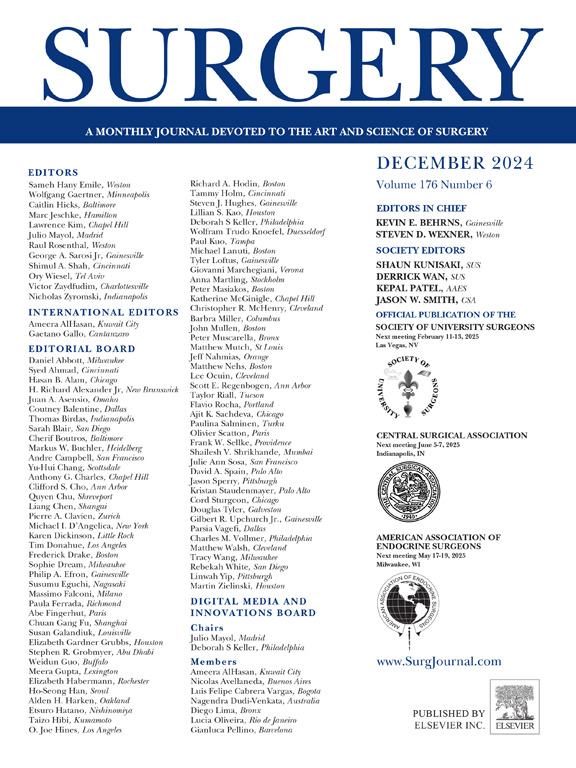Semisupervised home-based prehabilitation in patients undergoing pancreaticoduodenectomy: Impact on postoperative outcomes
IF 2.7
2区 医学
Q1 SURGERY
引用次数: 0
Abstract
Background
Prehabilitation is a relatively newer concept of utilizing the preoperative period for patient optimization to enhance the patient's physiological reserve. We planned a study to see the impact of a structured, multidimensional prehabilitative intervention on postoperative outcomes in patients undergoing pancreaticoduodenectomy.
Methodology
All consecutive patients planned for pancreaticoduodenectomy from January 2023 to June 2024 were assessed for enrollment. At least 2 weeks of semisupervised home-based prehabilitative intervention was done that included physical exercises, nutritional optimization, smoking cessation, and comorbidity optimization. Postoperative outcomes were recorded that included postoperative pancreatic fistula (POPF), complications grade, delayed gastric emptying, postoperative hospital stay, readmission rate, and mortality. Postoperative outcomes were compared with a historical control group of 81 patients.
Results
Of the 85 patients who were assessed for inclusion, 58 patients completed the prehabilitation program and underwent pancreaticoduodenectomy and were finally analyzed. The median age of the study group was 58 (interquartile range 45, 63.2), and 29 (50%) were male. Prehabilitation intervention resulted in improved weight control (median 56.5 kg [interquartile range 51.2, 67] vs 55 kg [ 49.2, 67.5], P < .001), increase in breath hold time (median 32 [interquartile range 28, 35] vs 28 [24, 33.5] seconds, P < .001), higher prognostic nutritional index (median 45.5 [interquartile range 39.5, 49.6] vs 47.8 [42.4, 50.8], P = .003), and increased gait speed (median 0.66 [interquartile range 0.58, 0.75] vs 0.54 [0.50, 0.66] m/s, P = .001). Clinically relevant postoperative pancreatic fistula (18 [22.2%] vs 11 [19%], P = .64) and major complications were similar between the prehabilitation and control groups (17 [29.3%] vs 24 [29.6%], P = .96). The mortality in the control group was higher compared with that in the prehabilitation group (6.3% vs 1.7%).
Conclusion
Semisupervised home-based prehabilitation is effective in improving physiological parameters and functional capacity in pancreaticoduodenectomy. However, establishing the definite role of prehabilitation in pancreaticoduodenectomy to improve postoperative outcomes needs a large randomized study.

半监督家庭康复对胰十二指肠切除术患者术后预后的影响
预康复是一个相对较新的概念,它利用术前优化患者以增强患者的生理储备。我们计划进行一项研究,观察结构化、多维度的康复干预对胰十二指肠切除术患者术后预后的影响。方法对2023年1月至2024年6月计划行胰十二指肠切除术的所有连续患者进行入组评估。至少进行2周半监督的家庭康复干预,包括体育锻炼、营养优化、戒烟和合并症优化。记录术后结果,包括术后胰瘘(POPF)、并发症等级、胃排空延迟、术后住院时间、再入院率和死亡率。术后结果与历史对照组81例患者进行比较。结果在85例纳入评估的患者中,58例患者完成了康复前计划并接受了胰十二指肠切除术,并最终进行了分析。研究组的中位年龄为58岁(四分位间距为45,63.2),其中29名(50%)为男性。康复前干预改善了体重控制(中位数56.5 kg[四分位数间距51.2,67]vs 55 kg [49.2, 67.5], P <;.001),屏气时间增加(中位数32[四分位数间距28,35]vs 28[24,33.5]秒,P <;.001),更高的预后营养指数(中位数45.5[四分位数范围39.5,49.6]vs 47.8 [42.4, 50.8], P = 0.003)和步态速度增加(中位数0.66[四分位数范围0.58,0.75]vs 0.54 [0.50, 0.66] m/s, P = 0.001)。临床相关的术后胰瘘(18例[22.2%]vs 11例[19%],P = 0.64)和主要并发症在康复组和对照组之间相似(17例[29.3%]vs 24例[29.6%],P = 0.96)。对照组的死亡率高于康复组(6.3% vs 1.7%)。结论半监督式家庭康复能有效改善胰十二指肠切除术患者的生理参数和功能。然而,确定预适应在胰十二指肠切除术中改善术后预后的明确作用需要一项大型随机研究。
本文章由计算机程序翻译,如有差异,请以英文原文为准。
求助全文
约1分钟内获得全文
求助全文
来源期刊

Surgery
医学-外科
CiteScore
5.40
自引率
5.30%
发文量
687
审稿时长
64 days
期刊介绍:
For 66 years, Surgery has published practical, authoritative information about procedures, clinical advances, and major trends shaping general surgery. Each issue features original scientific contributions and clinical reports. Peer-reviewed articles cover topics in oncology, trauma, gastrointestinal, vascular, and transplantation surgery. The journal also publishes papers from the meetings of its sponsoring societies, the Society of University Surgeons, the Central Surgical Association, and the American Association of Endocrine Surgeons.
 求助内容:
求助内容: 应助结果提醒方式:
应助结果提醒方式:


